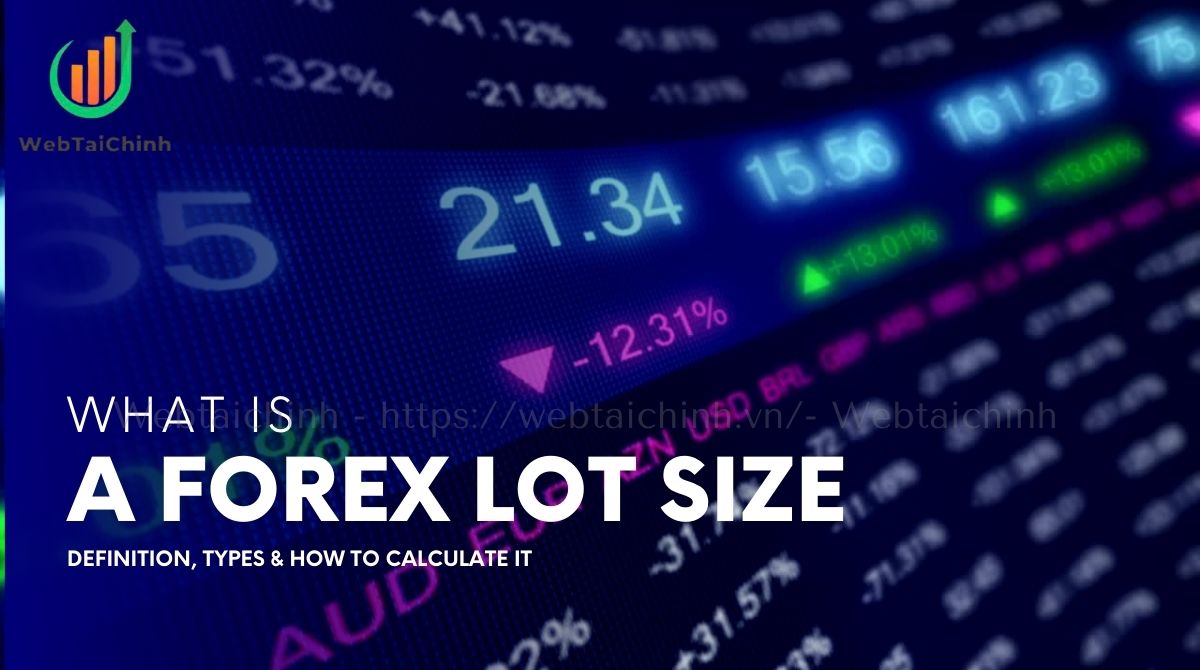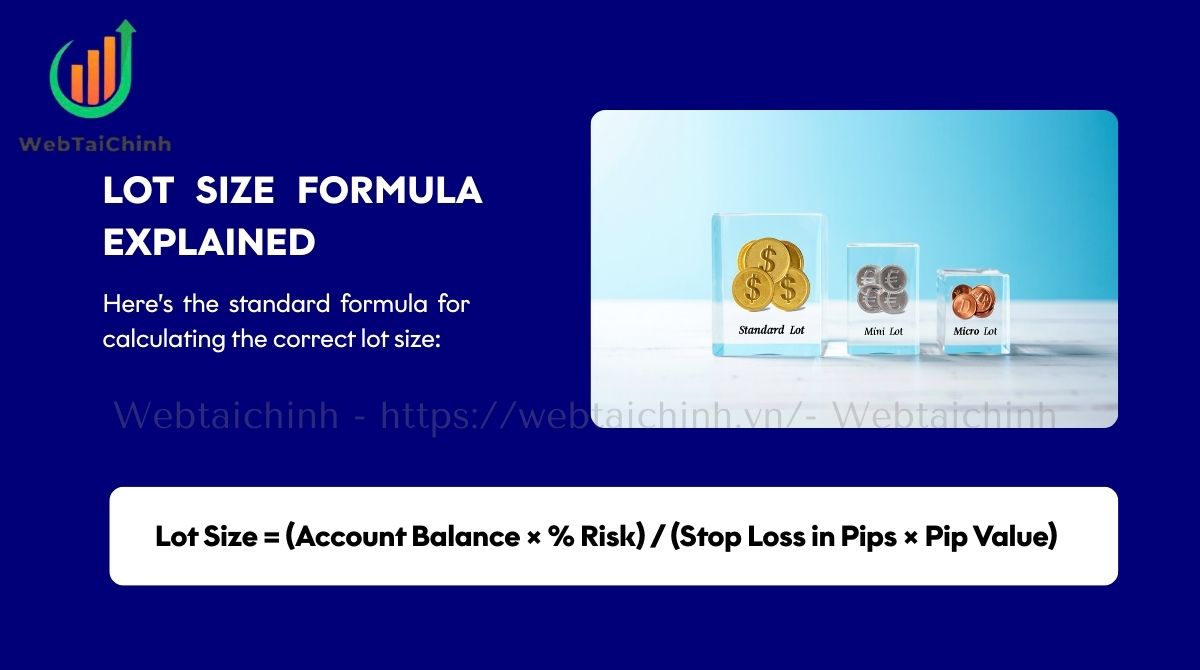Physical Address
304 North Cardinal St.
Dorchester Center, MA 02124
Physical Address
304 North Cardinal St.
Dorchester Center, MA 02124

What is a forex lot size and why does it matter so much in trading? A forex lot size refers to the number of currency units involved in a trade — and choosing the right size could mean the difference between consistent profits and unexpected losses.
For beginners and even seasoned traders, getting lot size wrong can blow your account due to poor risk exposure or miscalculated pip values. But when done right, it becomes a powerful tool to control risk, manage leverage, and match your trading strategy.
This guide from Webtaichinh helps you understand every type of lot size in forex (standard, mini, micro, and nano), how each one affects pip value and margin, and how to calculate the right lot size based on your account balance and risk tolerance. Whether you’re trading EUR/USD or exotic pairs, mastering lot size is the first step to mastering your trades.
Key takeaways:
Ready to size your trades the smart way? Let’s break it down.
In forex trading, a lot refers to a standardized number of currency units bought or sold in a single transaction. Instead of dealing with individual units like 1 USD or 1 EUR, traders use lot sizes to simplify trade execution, pip value calculations, and risk management.

The concept of lot size allows traders to scale positions appropriately depending on their account size, strategy, and risk appetite. For example, trading 1 standard lot means you’re buying or selling 100,000 units of the base currency — a position size that significantly amplifies both potential profits and losses.
By using lot sizes, traders can better manage their exposure and maintain consistency in trade sizing across different pairs and platforms. This standardization is essential because price movements in forex are measured in small units called pips, and even a small pip change can translate into large financial impact depending on your lot size.
The most commonly used lot sizes include:
Standard lot: 100,000 units
Mini lot: 10,000 units
Micro lot: 1,000 units
Nano lot: 100 units
Each of these lot types caters to different account sizes and risk levels. Beginners typically start with micro or nano lots to limit exposure, while experienced traders may scale up to standard lots as they build confidence and capital.
Forex trading offers multiple lot sizes to accommodate different trading styles, risk tolerances, and account balances. Understanding the distinction between standard, mini, micro, and nano lots is essential for sizing trades correctly and avoiding overexposure.

A standard lot represents 100,000 units of the base currency. It is commonly used by institutional or professional traders due to its large size and higher capital requirement.
Example: In a EUR/USD trade, buying 1 standard lot equals buying €100,000.
Pip value: Approximately $10 per pip (for most USD-quoted pairs).
A mini lot represents 10,000 units of the base currency. It’s ideal for intermediate traders or those with moderate account balances who want more control over risk.
Example: Buying 1 mini lot of GBP/USD equals buying £10,000.
Pip value: Roughly $1 per pip.
A micro lot represents 1,000 units of the base currency. This size is popular among beginners who are still learning or trading with small accounts.
Example: Trading 1 micro lot in USD/JPY means buying 1,000 USD.
Pip value: About $0.10 per pip.
A nano lot represents 100 units of the base currency. While not supported by all brokers, nano lots offer ultra-small trade sizes perfect for testing strategies or extremely conservative risk profiles.
Example: A 1 nano lot trade in EUR/USD equals €100.
Pip value: Around $0.01 per pip.
| Lot Type | Units of Base Currency | Pip Value (EUR/USD) | Common Usage |
|---|---|---|---|
| Standard Lot | 100,000 | $10 | Institutional, advanced traders |
| Mini Lot | 10,000 | $1 | Intermediate traders |
| Micro Lot | 1,000 | $0.10 | Beginners, low-risk traders |
| Nano Lot | 100 | $0.01 | Strategy testing, ultra-low risk |
Choosing the appropriate lot size depends on your account balance, risk tolerance, and trading goals. For many beginners, starting with micro or mini lots is the safest way to gain market experience while preserving capital. Knowing what is a forex lot size helps you select the right trade volume without guessing or overexposing your account.
Lot size is more than just a trade quantity—it’s a direct multiplier of your risk, profit, margin, and exposure. Selecting the wrong lot size can magnify losses or wipe out your account quickly. Understanding how it ties into key trading mechanics is essential for building a sustainable strategy.
Let’s break down the four critical ways lot size impacts your trades.

A pip (percentage in point) is the smallest unit of price movement in most forex pairs—typically the fourth decimal place (0.0001), or the second for yen pairs (0.01). The value of a pip increases with the lot size:
| Lot Size | Units | Pip Value (EUR/USD) |
|---|---|---|
| Standard Lot | 100,000 | $10 per pip |
| Mini Lot | 10,000 | $1 per pip |
| Micro Lot | 1,000 | $0.10 per pip |
| Nano Lot | 100 | $0.01 per pip |
Example: If you’re trading 1 mini lot on EUR/USD and the price moves 15 pips in your favor, you would earn 15 × $1 = $15 profit.
Had you used a standard lot, that same move would yield $150.
Since profit or loss is calculated as:
P/L = Pip Value × Number of Pips Moved,
your lot size acts as a leverage on your outcomes. A larger lot means each pip is worth more—resulting in larger profits or larger losses.
This leverage effect can be either a strategic advantage or a dangerous trap, depending on how well your risk is managed.
Smaller lot = slower capital growth but reduced drawdowns.
Larger lot = faster growth potential but higher volatility and emotional pressure.
If you don’t fully grasp what is a forex lot size, your P/L swings can feel random and emotionally overwhelming.
Margin is the amount of capital a broker requires you to hold in your account to open and maintain a position. Larger lot sizes demand more margin, thereby limiting how many trades you can open simultaneously.
Example:
With 100:1 leverage, opening a standard lot (100,000 units) of EUR/USD requires approximately $1,000 in margin.
A micro lot (1,000 units) under the same leverage would require only $10.
Overleveraging through large lot sizes without proper margin management often leads to margin calls or stop-outs, especially during high-volatility periods.
Lot size and leverage are deeply interconnected. While leverage allows you to control larger positions with smaller capital, your lot size determines how much exposure you’re taking on that leverage.
A common mistake among new traders is to maximize leverage and lot size simultaneously, which compounds risk exponentially. Here’s how it connects:
Higher leverage with large lot size = massive exposure and low margin cushion.
Lower leverage with small lot size = safer, more sustainable growth.
Tip: Don’t use leverage as an excuse to oversize your positions. Instead, determine your ideal lot size based on risk management first, then apply leverage as needed.
Lot size acts as a pivot point between pip value, P/L swings, margin usage, and leverage impact. Mastering it means being in control of your trade risk and capital preservation—not just chasing returns.
Accurately calculating your forex lot size is non-negotiable if you want to manage risk, preserve capital, and build a consistent strategy. Guessing your position size or defaulting to a fixed lot amount (e.g., 0.1 lots every trade) is one of the fastest ways to overexpose yourself to the market.
This section shows you how to calculate the optimal lot size based on account size, risk tolerance, stop-loss distance, and pip value.
Before calculating your lot size, you need to define two things:
How much of your account you’re willing to risk per trade (commonly 1% to 2%).
The size of your stop loss in pips (based on technical analysis or strategy).
Rule of thumb: Never risk more than 2% of your trading capital on a single trade. Conservative traders often stay between 0.5% and 1%.
Here’s the standard formula for calculating the correct lot size:

Lot Size = (Account Balance × % Risk) / (Stop Loss in Pips × Pip Value)
Where:
Account Balance = Your total trading capital (e.g., $5,000).
% Risk = Decimal form of the risk per trade (e.g., 1% = 0.01).
Stop Loss in Pips = Number of pips between your entry and stop.
Pip Value = Monetary value per pip, based on the lot size.
The result of the formula gives you the lot size in standard lots. You can convert this into mini, micro, or nano lots depending on your broker’s platform.
Scenario:
Account balance: $1,000
Risk per trade: 1%
Stop loss: 25 pips
Pair: EUR/USD
Pip value per mini lot (0.1 lots): $1
Step-by-step:
Determine dollar risk = 1% of $1,000 = $10
Plug into formula:
Lot Size = $10 / (25 pips × $1)
Lot Size = $10 / $25 = 0.4 mini lots
Final Result: You should trade 0.04 standard lots, or 4,000 units, to stay within your 1% risk tolerance.
This hands-on calculation makes it clear why understanding what is a forex lot size is critical to proper risk alignment.
When trading pairs where JPY is the quote currency (e.g., USD/JPY) or any non-USD quote pair (e.g., EUR/GBP), pip values vary and require adjustment using exchange rates.
Adjustment tip:
For non-USD quotes, use this formula to determine pip value:
Pip Value = (0.0001 / Exchange Rate) × Lot Size
Then plug that pip value into the main lot size formula.
Example:
EUR/JPY at 145.50, trading 0.1 lots (10,000 units):
Pip Value = (0.01 / 145.50) × 10,000 ≈ $0.69 per pip
That adjusted pip value should be used when calculating your lot size.
If you want to avoid manual math or handle multi-currency pairs, consider using a free lot size calculator offered by many brokers or trading platforms.
You simply enter:
Account size
Risk percentage
Stop-loss distance
Currency pair
The calculator returns the optimal lot size in real time. While it’s always best to understand the math behind it, calculators help eliminate input errors and speed up decision-making.
Pro tip: Save a calculator bookmark in your trading journal or platform dashboard for quick access.
Summary: The right lot size is not about guessing or using round numbers. It’s about aligning your position with your capital, risk tolerance, and trade setup. When calculated correctly, it ensures your risk stays predictable and your strategy consistent—two essential ingredients for long-term trading success.
Lot size selection isn’t one-size-fits-all. The right position size depends not only on your account balance and risk tolerance, but also on how you trade—your frequency, holding time, and strategy type.
This section guides you on aligning lot size with your trading style, adapting to volatility, and avoiding common sizing mistakes.
Different styles require different levels of risk exposure and flexibility. Here’s how lot size fits into each one:
| Trading Style | Typical Trade Duration | Recommended Lot Approach |
|---|---|---|
| Scalping | Seconds to minutes | Small lots, tight stops, frequent trades |
| Day trading | Intraday (minutes to hours) | Medium lots, moderate stops, 1–3 trades/day |
| Swing trading | Days to weeks | Smaller lots, wider stops, fewer trades |
Scalpers operate with tight stop-losses (5–10 pips) and need to control risk through very small lots to avoid overleveraging due to rapid execution frequency.
Day traders can manage moderate lot sizes, balancing risk and opportunity over a few trades per day. They often keep risk below 1% per trade.
Swing traders, who hold trades longer and face more overnight exposure, should prioritize capital preservation by using small lot sizes and wider stop-losses—typically 30 to 100+ pips.
Volatility changes every day—and so should your lot sizing strategy. In highly volatile markets, even small pip moves can result in significant gains or losses.
To manage this:
Use ATR (Average True Range) to assess recent volatility.
Reduce lot size when volatility spikes (e.g., during major news events).
Increase lot size cautiously when volatility is low and predictable.
Example: If EUR/USD shows an ATR of 80 pips instead of the usual 40, reducing your lot size by 50% can help maintain risk equilibrium.
Choosing the wrong lot size is one of the top reasons traders fail. Here are 10 critical mistakes to watch for—and how to avoid them:
Setting lot size before defining stop-loss
→ Always calculate your stop-loss first, then compute lot size.
Ignoring pip value differences across pairs
→ Adjust for cross or JPY pairs using proper pip value math.
Overleveraging small accounts
→ Never exceed reasonable margin ratios, especially with large lots.
Using fixed lot sizes in all trades
→ Adapt your lot size based on volatility and setup quality.
Neglecting broker-specific lot minimums
→ Check your platform’s smallest allowable size before executing.
Confusing lots with units
→ Understand the equivalency to avoid oversized or undersized positions.
Skipping position sizing calculations entirely
→ Always run the math or use a calculator.
Failing to adjust for currency conversion
→ For non-USD accounts, use correct exchange rates in your formulas.
Ignoring margin requirements
→ Monitor available margin before stacking trades with large sizes.
Holding multiple lot sizes without consistency
→ Track your exposure across positions to avoid unexpected risk.
While the core concept of lot size remains consistent across forex platforms, how it’s represented, entered, and interpreted can vary significantly. Failing to understand these differences may lead to unintentional over-sizing or execution errors—especially when switching brokers or asset classes.

This section explains how spot forex, CFDs, and spread betting platforms use different conventions for trade sizing, and what that means for your risk management.
MetaTrader is one of the most widely used platforms for retail forex trading. It uses standardized lot denominations, with the flexibility to enter fractional lot sizes in decimal format.
Input type: Lots (e.g., 0.01, 0.1, 1.0)
Minimum size: Usually 0.01 lots (1,000 units = micro lot)
Increment: 0.01 lots
Displayed units: Not visible by default; only lots are shown
Example: Placing a trade with 0.10 lots means trading 10,000 units of the base currency (1 mini lot).
Many brokers using MetaTrader allow nano lots (0.001 = 100 units), but always verify your broker’s minimums.
Contracts for Difference (CFDs) are derivatives that mirror the price of underlying assets, including forex pairs. Unlike spot forex, CFD sizing may be expressed in contracts, units, or lots, depending on the platform.
Input type: Contracts, lots, or units (broker-dependent)
Minimum size: Often 1 contract or 1,000 units
Increment: Varies—some allow 0.01 contracts, others use full integers
Displayed units: Typically show contracts and margin requirements
Example: A broker may define 1 CFD contract of EUR/USD as 10,000 units, making it equivalent to a mini lot.
Always read the broker’s specification sheet or trading conditions document to understand how pip value and margin are calculated per contract.
Spread betting is popular in the UK and Ireland due to its tax advantages. It differs from other platforms by quoting position sizes as a stake per point, not lots or units.
Input type: Stake per point (e.g., £1/point, £0.10/point)
Minimum size: Varies by asset and provider
Increment: Typically 0.10 or 0.01 per point
Displayed units: Shows stake, not currency amount
Example: A stake of £1/point on GBP/USD means you gain or lose £1 for every 0.0001 move.
The underlying lot equivalent depends on how many points correspond to a pip move. Consult your spread betting provider’s pip value mapping.
| Platform Type | Size Input | Typical Minimum | Increment | Terminology |
|---|---|---|---|---|
| MetaTrader (FX) | Lots | 0.01 lots | 0.01 | Lots (standard, mini, micro) |
| CFD Platforms | Contracts or units | 1 contract / 1,000 units | 1 or 0.01 | Contracts or units |
| Spread Betting | Stake per point | £0.10/point or less | 0.01 or 0.10 | Stake per point |
Before placing a trade, always confirm:
Whether your platform uses lots, units, or contracts
The minimum trade size and allowed increments
How pip value and margin are calculated per size unit
Understanding these differences prevents confusion and ensures precise control over your position sizing—regardless of where or how you trade.
Related reads to deepen your knowledge:
For most beginners, starting with a micro lot (0.01 lots or 1,000 units) is safest. It keeps risk small while allowing real-money experience. Many new traders use micro or nano lots to test strategies and build discipline without risking significant capital.
One standard lot in forex equals 100,000 units of the base currency.
1 mini lot = 10,000 units
1 micro lot = 1,000 units
1 nano lot = 100 units
Understanding these sizes is key to calculating pip value and exposure.
A 0.01 lot represents a micro lot, or 1,000 units of the base currency. For EUR/USD, each pip is typically worth around $0.10, making it ideal for small accounts or conservative traders.
Yes, many brokers allow nano lot sizes (0.001 lots = 100 units), especially on platforms like MetaTrader. This is great for testing systems or trading with extremely low risk.
Absolutely. Larger lot sizes require more margin. For example, trading 1 standard lot typically needs $1,000 in margin at 100:1 leverage, whereas a micro lot may only require $10. Always check your broker’s margin policy.
Understanding what a forex lot size is gives you full control over your exposure, risk, and profitability. Whether you’re trading standard, mini, micro, or nano lots, choosing the correct size directly affects your pip value, margin usage, and emotional discipline.
Mastering lot sizing is not optional—it’s fundamental to becoming a consistently profitable trader.
Key takeaways:
Choosing the right lot size is the first step to professional-grade trading. With a solid understanding of lot sizing, you can avoid the most common rookie mistakes and begin scaling your performance safely and strategically.
Web Tai Chinh is a portal that updates news and information related to finance quickly and accurately, helping users have an overview before investing, clearly understanding concepts and terms related to Finance. Explore more insights in our Forex category, start your FX trading journey today with the right partner for long-term success.
📞 Contact: 055 937 9204
✉️ Email: webtaichinhvnvn@gmail.com
📍 Address: 13 Ho Tung Mau, An Binh, Di An, Binh Duong